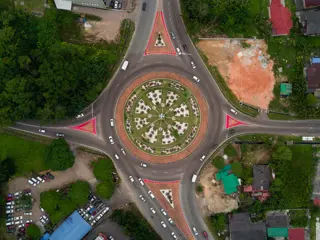Bangalore’s Satellite Town Ring Road: A Catalyst for Peripheral Real Estate Growth
 The Satellite Town Ring Road (STRR), a 280.8 km infrastructure mega-project encircling Bengaluru, is set to change real estate dynamics in Karnataka’s outskirts. As NHAI builds this access-controlled expressway under the Bharatmala Pariyojana, strategic zones around satellite towns are becoming prime investment spots. This article looks at how better connectivity turns underused peri-urban areas into growth hubs.
The Satellite Town Ring Road (STRR), a 280.8 km infrastructure mega-project encircling Bengaluru, is set to change real estate dynamics in Karnataka’s outskirts. As NHAI builds this access-controlled expressway under the Bharatmala Pariyojana, strategic zones around satellite towns are becoming prime investment spots. This article looks at how better connectivity turns underused peri-urban areas into growth hubs.
Strategic Investment Zones Along the STRR Corridor
The STRR connects 12 satellite towns, including Doddaballapur, Devanahalli, Hoskote, Anekal, Ramanagara, and Magadi. While parts like the Hoskote-TN Border stretch are almost complete (scheduled for March 2025), other sections offer great potential:
- Hoskote-Doddaballapur Axis: Close to industrial corridors and the upcoming Hoskote Node of the airport project, this area is a logistics and manufacturing hub.
- Kanakapura-Harohalli Belt: Scenic areas for premium residential developments and nature-centric vacation homes.
- Anekal-Sarjapur Corridor: Benefits from IT infrastructure and tech talent migration.
- Devanahalli-Hoskote Zones: Infrastructure spillover from the Bengaluru Airport Authority's expansion plans.
- Magadi-Ramanagara Stretch: Opportunities for warehousing and light industrial units.
Market Shifts: From Stalled Growth to Unlocked Potential
| Aspect | Pre-STRR Scenario | Post-STRR Projections |
|---|---|---|
| Connectivity | Limited radial roads | 6-lane access control highways |
| Travel Times | 2+ hour commutes to CBD | 45-60 minute CBD access |
| Land Values | Fluctuating in isolation | Predictable growth trajectories |
| Development Mix | Sprawling residential plots | Integrated townships & Mixed-use |
The immediate effect will be realpathypsum scarcity reduction in high-pressure areas like Hebbal and Outer Ring Road (ORR), allowing capital to flow outward. NHAI plans to divert 40-50% of intercity traffic from Bengaluru’s core, directly benefiting peripherals.
Key Opportunities for Investors
Logistics and Warehousing Potential
- Hoskote-Doddaballapur: Close to NES master plans, making this zone ideal for Grade-A warehouses.
- Ramanagara-Magadi: Direct access to iron ore and granite reserves for industrial-specific logistics parks.
Affordable Housing Developments
- Kanakapura-Banashankari: New projects near tech hubs attract IT professionals seeking shorter commutes to tech clusters.
- Sarjapur-Attibele: Emerging education hubs and transit-oriented developments.
Recreational and Tourism Properties
- Magadi-Kengeri: Wellness resorts and weekend homes along bio-diverse corridors.
- Harohalli-Nelamangala: Farm stays and agri-tourism projects leveraging Karnataka’s rural landscapes.
Challenges and Mitigation Strategies
While the STRR offers opportunities, investors must tackle:
- Land Acquisition Delays: Advocate for streamlined policy interventions.
- Zonal Regulations: Engage with Urban Development Authority for compatible land-use plans.
- Infrastructure Gaps: Explore PPP models for utilities supplementation.
Conventional wisdom suggests focusing on secondary demand zones rather than undeveloped areas. Early entrants in urban restaurants and land banks near proposed interchanges could reap multifold returns through strategic development partnerships.
The STRR isn’t just a road it’s a mobility ecosystem reshaping Bengaluru’s urban sprawl into a cohesive metro region. As completion targets align with the 2025-2027 timeframes, peripheral markets are set to witness transformational investment cycles that align with India’s smart city aspirations.